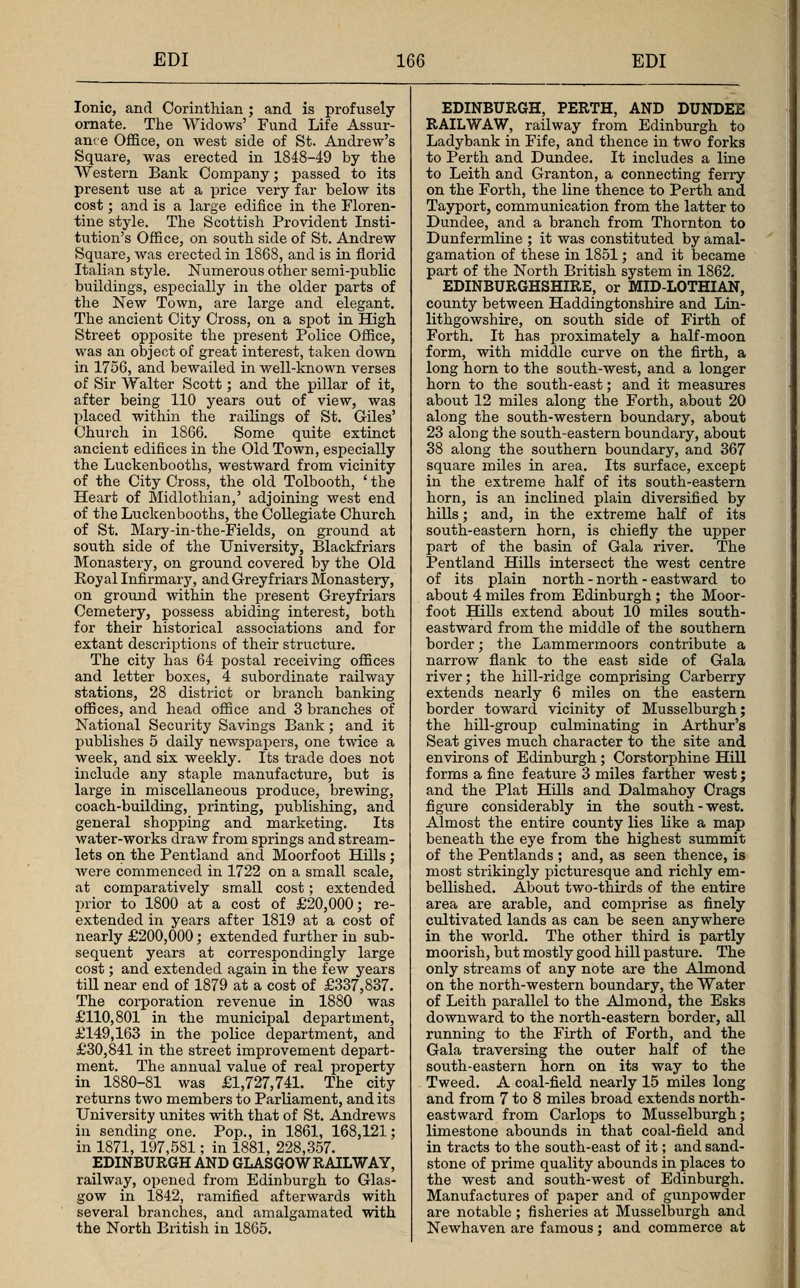EDINBURGH AND GLASGOW RAILWAY, railway, opened from Edinburgh to Glasgow in 1842, ramified afterwards with several branches, and amalgamated with the North British in 1865.
EDINBURGH, PERTH, AND DUNDEE RAILWAYrailway from Edinburgh to Ladybank in Fife, and thence in two forks to Perth and Dundee. It includes a line to Leith and Granton, a connecting ferry on the Forth, the line thence to Perth and Tayport, communication from the latter to Dundee, and a branch from Thornton to Dunfermline ; it was constituted by amalgamation of these in 1851 ; and it became part of the North British system in 1862.
EDINBURGHSHIRE, county between Haddingtonshire and Linlithgowshire, on south side of Firth of Forth. It has proximately a half-moon form, with middle curve on the firth, a long horn to the south-west, and a longer horn to the south-east ; and it measures about 12 miles along the Forth, about 20 along the south-western boundary, about 23 along the south-eastern boundary, about 38 along the southern boundary, and 367 square miles in area. Its surface, except in the extreme half of its south-eastern horn, is an inclined plain diversified by hills; and, in the extreme half of its south-eastern horn, is chiefly the upper part of the basin of Gala river. The Pentland Hills intersect the west centre of its plain north-north-eastward to about 4 miles from Edinburgh ; the Moorfoot Hills extend about 10 miles south-eastward from the middle of the southern border; the Lammermoors contribute a narrow flank to the east side of Gala river; the hill-ridge comprising Carberry extends nearly 6 miles on the eastern border toward vicinity of Musselburgh; the hill-group culminating in Arthur's Seat gives much character to the site and environs of Edinburgh ; Corstorphine Hill forms a fine feature 3 miles farther west ; and the Plat Hills and Dalmahoy Crags figure considerably in the south-west. Almost the entire county lies like a map beneath the eye from the highest summit of the Pentlands ; and, as seen thence, is most strikingly picturesque and richly embellished. About two-thirds of the entire area are arable, and comprise as finely cultivated lands as can be seen anywhere in the world. The other third is partly moorish, but mostly good hill pasture. The only streams of any note are the Almond on the north-western boundary, the Water of Leith parallel to the Almond, the Esks downward to the north-eastern border, all running to the Firth of Forth, and the Gala traversing the outer half of the south-eastern horn on its way to the Tweed. A coal-field nearly 15 miles long and from 7 to 8 miles broad extends north-eastward from Carlops to Musselburgh; limestone abounds in that coal-field and in tracts to the south-east of it ; and sand-stone of prime quality abounds in places to the west and south-west of Edinburgh. Manufactures of paper and of gunpowder are notable ; fisheries at Musselburgh and Newhaven are famous ; and commerce at Leith and Granton is great. The Cale-donian Ottadini and Gadeni, the Eomans, and the Anglo-Saxons, had successive possession of the territory, and have all left interesting remains ; and later occupants have contributed the extant antiquities of Borthwick, Crichton, Dalhousie, Eoslin, Eavensnook, Cousland, Catcune, Locher-wart, Luggate, and Craigmillar Castles, the last a structure of much note. The towns with each more than 40,000 inhabitants are Edinburgh and Leith ; with each more than 5000 are Musselburgh, Dalkeith, and Portobello; with each more than 2000 are West Calder and Penicuick ; with each more than 1000 are Bonnyrigg, Lasswade, Loanhead, Jock's Lodge, Granton, and Addiewell; and the villages with each more than 300 amount to 36. The annual value of real property in 1880-81, exclusive of Edinburgh, Leith, Musselburgh, andPorto-bello,was 688,167. Pop., in 1861, 273,997 ; in 1871, 328,379 ; in 1881, 388,977.

